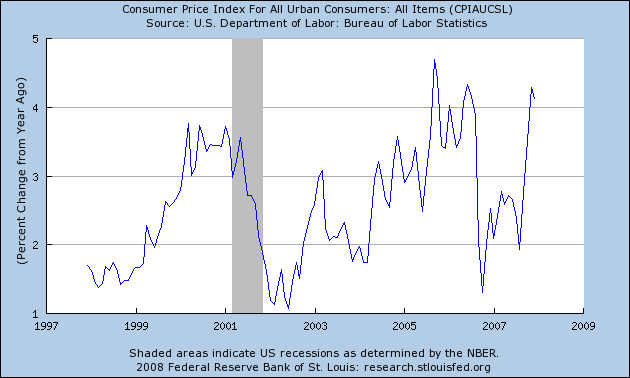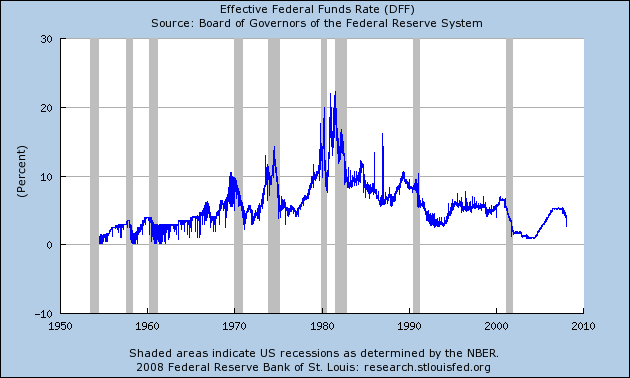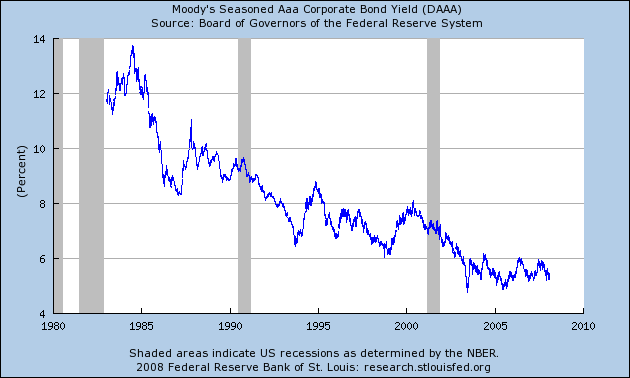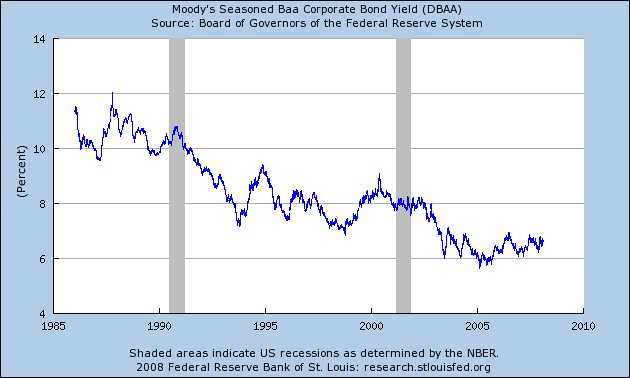Federal Reserve officials are acknowledging increasing weakness in the economy, signaling a willingness to cut rates again at their next meeting. But inflation concerns are rising among some officials, indicating the magnitude of their next move may be a matter of contention.
.....
Some officials, however, expect growth to rebound in the second half, and they are wary of cutting rates so low now that they would spur higher inflation as the economy recovers. Monetary policy works with a lag, so interest-rate cuts tend to boost the economy six months to a year after they are implemented.
"The Fed has to be very careful now to add just the right amount of stimulus to the punch bowl without mixing in the potential to juice up inflation once the effect of the new punch kicks in," Richard Fisher, president of the Federal Reserve Bank of Dallas, said in a speech in Mexico City yesterday. Mr. Fisher dissented in the Fed's latest vote, which lowered the interest-rate target half a point.
Charles Plosser, president of the Federal Reserve Bank of Philadelphia who also is on the voting rotation this year, suggested this week that he would need to see a deeper deterioration in the economy -- beyond the weak numbers already expected -- to support further easing.
But Mr. Plosser, who backed the last two rate cuts, said he expects "little progress" in lowering a key inflation measure this year or next, "and I am skeptical that slower economic growth will help," he said. "All you have to do is recall the 1970s when we experienced both high unemployment and high inflation to appreciate that slow economic growth and lower inflation do not necessarily go hand in hand."
This has been one of the main reasons I have argued against the rate cuts over the last few months. The bottom line is inflation is nowhere near a good level.
Here is a chart of the year-over-year change in inflation:

And here is a chart of the year-over-year change in money growth

Inflation looks really tame, doesn't it (end really sarcastic, smart-ass tone)
I first started to become concerned about inflation after my twice weekly shopping trips. I noticed that things I buy regularly -- milk and chicken -- were increasing in price to uncomfortable levels. In Houston Texas, a gallon of milk was roughly $2.99/gallon for the longest time. Over the last 6 months it has increased in price to $3.39/gallon. Bonless skinless chicken has increased from approximately $5.50/package (roughly 4 chicken breasts) to over $7.00 package. Then I started to listen to check-out conversation and it was all centered on prices. I realize the Bonddad's shopping list is hardly exciting reading, but this is where my concern started.
Now we have stories like these about agricultural prices hitting record highs and inflation hedging commodites like gold and sliver doing likewise. Anyone who follows these markets -- wheat, corn and the like -- has seen huge price increases over the last 5-7 years. While the Fed was concerned about "core" inflation -- great if you don't eat or drive anywhere but completely useless for anything else -- non-core inflation was running through the roof.
And it's not as though interest rates were sky high in the first place. Take a look at the following charts from the St. Louis Federal Reserve:
Effective Federal Funds:

10-Year CMT

30-Year CMT

AAA Corporate paper

BBB Corporate paper

Interest rates are cheap beyond belief. It's not as though money is expensive right now. The central problem isn't the cost of money -- it's a poorly managed financial sector. But thanks to 17 years of Alan "cheap money" Greenspan, we're all use to the Fed cutting rates whenever we feel economic pain. Thanks for nothing.
So now we hear the Federal Reserve actually talking about inflation. That's nice. It's what they should have been talking about all along.